London Fashions November 1887
By Mrs. Johnstone
Years and years ago, worthy Philip Stubbes waxed eloquent on the subject of earrings Speaking of women, he wrote:
"They are so far bewitched as they are not ashamed to make holes in their ears where they hang rings and other jewels of gold and precious stone. However, what this signified, in them I will hold my peace, for the thing itself speaks sufficiently."
Fashion Accessories for Women
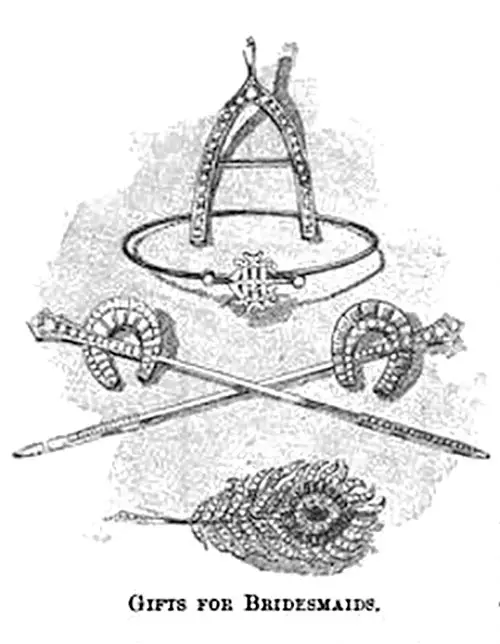
Gifts for Bridesmaids
Now, in this year of grace 1887, other people have come to think as he did, for earrings have gone out of fashion. Satirists and critics may inveigh as they like, apparently sermonizing does little good, unless La mode goes with them.
Holbein, Albert Dürer, Cellini, and a host of other distinguished artists have not disdained to apply their talents to designs for women's ornaments.
Now it would seem that quaint and homely articles serve for the models which please women most, especially for pins and brooches, and it is only occasionally that we fall back upon those beautiful old medieval and Etruscan patterns which, in point of beauty, have few rivals.
Nevertheless, the curious merrythought and peacock's feather brooches in our illustration (shown above) would please most people: they are all encrusted with diamonds, emeralds playing their part in the feather, which is a faithful copy of a real one.
Diamonds and pearls are most fashionable. Possibly at some remote period, every diamond in the world has formed a part of a glowing plant.
Science teaches us to regard them as concentrated gas and sunbeams, with a small percentage of ash or earthy salt, and world-lings are apt to remember that, besides enhancing their charms, "Diamonds are portable, and that diamonds are property."
Pearls would seem to suit only young and pretty women. Madame de Montespan was always bedecked with them, and Ann of Austria possessed the most lovely pearl necklace in the world; they used to be considered the necessary parure of a Maid of Honor.
Young girls wear a single row around the throat, and single bangles of pearls are most popular. The bangle in the illustration above is made on a new principle, introduced by Messrs. London and Ryder.
It expands in the opening for the hand to pass through, and closes again, tilting the arm tightly. There is no fear of its getting out of order.
Many of these bangles have been given during the season as presents to bridesmaids, bearing the monogram of bride and bridegroom, or this Jubilee year, with the date in diamonds.
Diamond pins are often worn in the hair, with stars or without them, and the model given above passes quickly through the hair, the jeweled point being slipped on afterward.
Best Materials for Autumn and Winter
All kinds of materials will be worn this autumn and winter, rich brocaded silks, plain silks and velvets, striped silks, heavy matelassés in a beautiful consolidation of color, which speak well for our artistic perceptions of tints, but woolens will be in the ascendant.
Checks and stripes are often worn alone for a country and serviceable gowns of a certain class, but there is a disposition to blend the plain materials, with the more elaborately woven fabrics, which are the distinctive feature of the season.
There is a long list of small and large-checked velvets made only for trimming, and usually applied as plain petticoats or panels, waistcoats, collars, and cuffs.
Velvet weaving has also been applied to twilled and chevron grounds in plain colors entirely composed of wool. The patterns are large and bold, mostly reproductions of the designs which have been handed down to us from the reign of Louis XV, and those who immediately succeeded and preceded him.
Autumn and Winter Dress Fashions
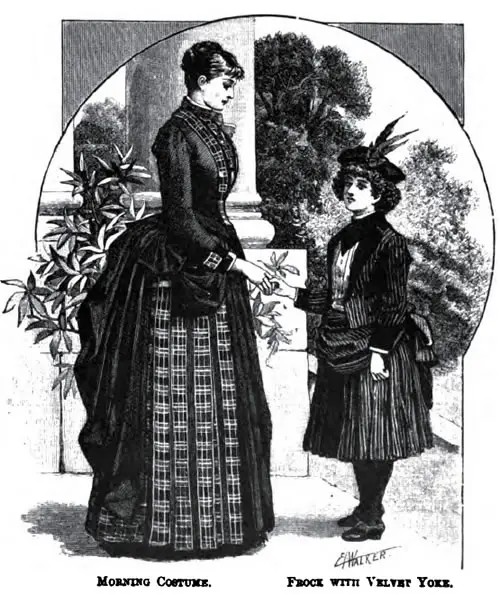
Morning Costume and Frock with Velvet Yoke - 1887
They are undoubtedly expensive, but they make beautiful gowns. The morning dress designed by Messrs. Dickins and Jones, of Regent Street, and here sketched, shown the style in which such materials may be made up.
The mode of draping is entirely new. The dress is composed of a grayish-blue cashmere, with panels of the woolen brocade, and shows off the soft folds of the cashmere to perfection, revealing, as if by chance, the full beauty of the brocade.
The cut of the bodice is novel. The velvet points introduced in front give additional length to the figure, and the use of piping, which for some time has been almost discarded, lends firmness to the edge. It has a habit Basque, and velvet forms the revers.
Dress artists are now compelled to study with peculiar care the lines of the human form divine. The long folds in which co many skirts are allowed to fall are not easy to arrange.
The fundamental principle would seem to be to allow the center of the front to fall as it will, introducing some three or four pleats on either side a few inches below the waist.
They arrange themselves differently on almost every figure. The back has to be kept well out by the foundation and under-propping, which should be steel, placed high up, with only one below it.
This necessitates the opening to come a little to the side, and not in the exact center of the buck. A large poof at the back of the waist is in bad style.
What is needed is that the folds should be caught up slightly in the way they most naturally fall, taking care that they do not give the impression of too great width. This is the way in which most dresses are made when they are composed only of one material.
Children's Clothing Fashions
Children are being dressed in woolens also for every day, as well as for evening wear, except perhaps for very full-dress occasions, when plush or corded silk is used, but they are the exceptions rather than the rule.
There is no radical change in the make of frocks; red and neutral tones are most worn, and some of the plain colors have interwoven patterns adapted to the borders of skirts, and the trimmings of bodices and sleeves.
The Norfolk blouse is found to be so useful and comfortable, that many school dresses are in that style. The frock here engraved, made by Messrs. Clack, shows another useful and becoming mode of manufacturing.
It would be suitable for girls of almost any age from five or six to nine or ten. The skirt is pleated. There is a sash tunic which appears beneath the jacket bodice; this has a pointed velvet yoke which is new.
It could be made up all of one tone, or in contrast, for example, the velvet ruby, the dress itself cream, or two shades of brown would look admirably well.
Walking, Driving or Evening Wear
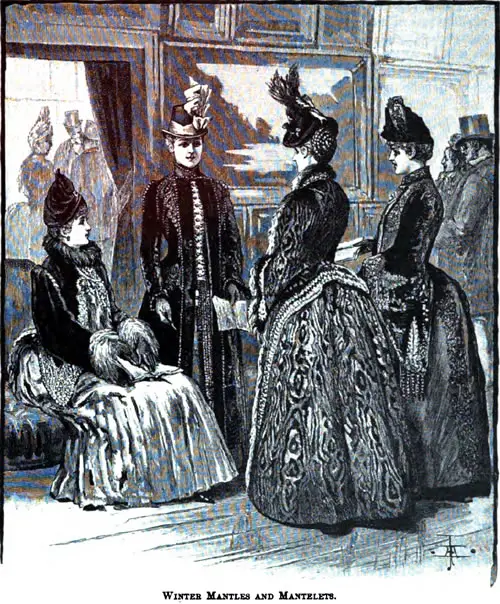
Winter Mantles and Mantelets
The time has come when a warm mantle is most acceptable. The first in our illustration (shown above) is well adapted to three purposes for walking, driving, or evening wear. It is made in a brown figured camel-hair cloth, soft, warm, and undeniably handsome.
It is trimmed with braided passementerie and lace. Long points of plush distinguish the shape, which is calculated to give a majestic grace to the figure, and it would suit either a short or tall woman.
The clasps introduced upon it are very well wrought. It is lined with pale blue striped silk and is very light, which is a good point in long cloaks; it is so difficult to combine warmth and lightness.
It can be made in any tone desired, such as fancy gray camel-hair with black trimmings, or if it is intended for evening only, in crimson velvet.
Women with good figures cling to the coat shape; in velvet such coats are apt to wear out too quickly; in cloth they are not important enough for all occasions, but plush has none of the drawbacks; and it is in myrtle-green plush with rich gray, gold, and black trimmings that the coat is made which appears in our sketch.
It has a gimp girdle coining from beneath the side revers, and the passementerie and the drooping cords tagged at the tips significantly distinguish it.
It has two large pleats at the back, which are just gathered at the top, and it opens the entire length of the skirt quite in the center, so there is no fear, with ordinary care, that it will be unduly crushed when its wearer sits down.
English women have not yet so far sacrificed themselves to the exigencies of dress as to wear garments in which they can only stand or walk, as fashionable women in other countries have the credit of doing.
This coat is lined with satin and has imitation but great looking pockets at the sides. Several Royal ladies have looked with favor on this particular cloak, and many of the same styles are being made for Sandown and other gatherings of a similar class.
Brocaded velvets, as well as brocaded cloth, are used for this year's mantles, but not much of the least expensive kinds of velvet brocade. Peau de wire façonné is newer and more durable.
Hitherto peso de soie has presented a plain surface and has been principally used for low bodices. Now it has been brought out much thicker, solely for panels, and covered with brocade, the design generally in stripes sufficiently far apart to display the ground well, and never very stiff or regular wears well and shows off the many beautiful trimming' introduced this season.
Velvet, as well as silk, has met with novel treatment, and for the first time has appeared with a watered surface, and it is of watered velvet that the third mends is made. It is trimmed with chenille and gold, is pointed at the back, has large sleeves, with fur introduced down the front, around the neck, and on the sleeves.
The last figure wears a shorter make of mantle which is also much worn. The material is brown plush, and coral is introduced into the beadwork with bronze and tinsel. Labrador fur is used upon it, which is white at the tips.
This could be equally well carried out in the fashionable matelassés, which when they were worn some years ago established their fame for looking well and wearing well It is a wonder they have not been reintroduced before.
There will, no doubt, be more black mantles sold this winter than any others, but some of the most beautiful Paris models are brown or dark green—naturally, they require bonnet and dress to be in unison; whereas a black cloak can be worn with everything, hence its popularity.
Some of the newest bronze cloaks have chenille passementerie and feather trimming of a new kind—cock feathers being used instead of marabouts. In many of the new galons, no beads are introduced, but they are elaborately made with cord, and wherever it is possible a tinsel effect is a result.
Formerly only one class of trimming was introduced on one cloak, and if the fur was used nothing else was required; now fur is supplemented by galons, and beautiful ornaments of every kind, and deep tagged chenille fringes and bead fringes appear from beneath the fur borders.
Elderly women need to choose cloaks with discretion, especially where a reduction of the apparent bulk of the wearer his to be considered.
Some of this year's shapes have been designed primarily for the purpose, with long, wing-like sleeves which fall at the side in such a way that they combine to diminish the width. A few of these are made in poult de soie façonné and are light in weight.
Many smart-looking mantles are to be had which are not overwhelmingly costly, and some of the newest are made with hoods and trimmed with Russian hare, which, like the Lapland fox, is tipped with white resembles many other furs now worn, for it is dyed, and by an ingenious process the tips, covered with acid, do not take the color but remain white. Gray furs are worn again, blue-gray of tone after the order of blue fox but darker.
The new skin of this kind is called Mouflon, and it is of this that many of the long boas are made which teach to the feet English women have long throats and wear high collars, and these soft fur boss suit them so well that each year they come back into favor with such changes ems the furriers and mantle-makers can devise.
It must be the hardest of hard work to invent new things, and nobody yet has been able to speak authoritatively and decidedly as to who it is we have to thank for the follies and instances of good and bad taste for which Dame Fashion is responsible.
Paris at one time reigned supreme, now she only takes her part, and if any particular success of the moment is traced to its source, it generally has caprice for its origin, for which a pretty woman is responsible.
Sometimes those who provide are able, luckily for them, to induce their customers to buy what they have, and be content therewith, but the public has acquired a habit of deciding for themselves, to drive and not be driven, so there is more of speculation that is altogether desirables when novelties are laid before critical community, who know what they want and will have it.
Fur Fashion
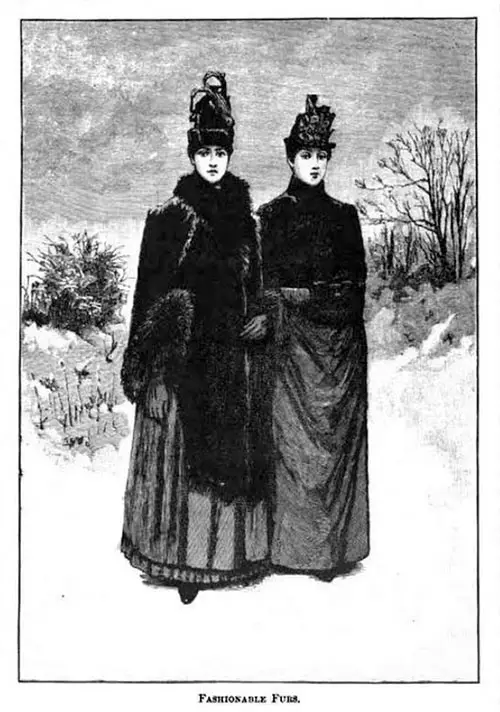
Fashionable Furs
Sealskin never goes long out of favor. The newest sealskin jackets are quite short and are sometimes made claw-fitting hack and front, sometimes only in the back, loose and double-breasted in the front, fastened with large brown buttons, and having a revers at the throat.
Some of the most beautiful seal coats reach to the ground, but it is newer to have them made short at the back, long in front, forming two ends, and bordered with fox-fur. To make them complete, they must be accompanied by a muff to match.
There is nothing very new in the shape, they taper towards the top and widen at the base, and sometimes tiny beaver heads are introduced, or butterflies made in fur, or merely a bow of ribbon.
The chief point is that the fur should be useful in color and close in the pelt. Toques are made to be worn with them, with a bunch of cock's feathers or a parrot's head and wings nestling at the side.
Toques are large, and many of them are pointed above the face; they were apt to hide the hair in front too much. The Olivia cap, followed by the Olivia bonnet, gave the idea which has been now wisely applied to toques.
Fur capes have assumed many new forms Some are shaped to the shoulders and do not disguise the figure quite so thoroughly as they were wont to do; some are mere plastrons covering the cheat well and forming a point at the waist.
Others, like that in our illustration above, take the form of a habit-shirt, with epaulets of gimp, to which cords are attached which cross the chest and fasten on the opposite side. They are particularly smart-looking, and in truth are almost, if not entirely, as warm as any mantle.
Sable is always well worn by those who can afford it, although it fluctuates much in price, but is not so costly this year as it is sometimes. Beaver is used for trimmings, being of a color that goes well with the tone of cloth now in vogue, most of the winter clothing having what is called beaver linings, viz., a soft interwoven lining.
Fox and skunk are always to the fore, and some of the best fox skins are very good indeed. Chinchilla has been brought back to favor for children's wear, entire hats being made of it, with brims that turn up from the face.
Care has to be taken in choosing fine, close skins, and then they are the very things for children. Bonnets are made of it, lined with soft pink, and with a cape of many loops of pink ribbon; the gray of the fur forms the happiest contrast with the pink.
It also trims the sot woolen stuffs well of which their little cloaks are made; and sheepskins, with the fleece, uncurled, but combed, are also used, for the double-breasted paletots, and give gent satisfaction, for they feel soft, and, moreover, look new whenever they are combed and washed.
Fashionable Hats and Headgear
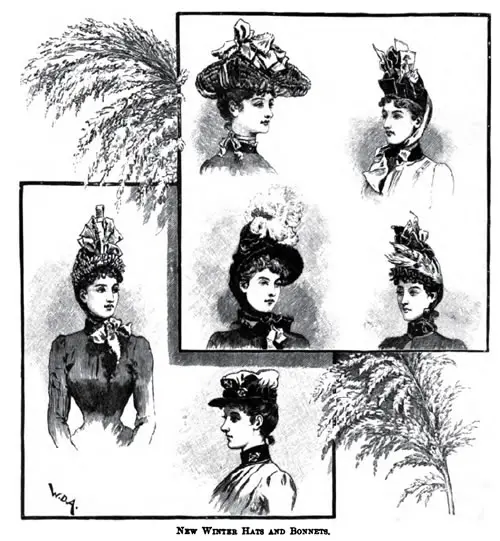
New Winter Hats and Bonnets
If it is true that the possession of a new bonnet can considerably assuage most of the woes of women, this should be a happy time, for there are not only many new bonnets, but a great variety in them. In our engraving (shown above) the leading shape, are shown.
"The Queen" is the name given to the one with the flaring crown because it is not very unlike what our Gracious Sovereign wore st the period when she ascended the throne.
It is equally as well suited to a child as to a grownup person, and it is becoming to young women and old. It is drawn at the edge, the crown is stiff, and there is a group of feathers at the aide; the strings come entirely from the back, and above the face the inside lining is visible.
Watered velvet is much worn in millinery, and it frequently appears in the new bonnets is of gray watered velvet that the bonnet is made which is arranged in three pleats over the face, forming a poof, supported by wings, which give it great height
This is a style which is generally worn, and it is not difficult to carry out, for the wings are trimming in themselves, and the material between falls in natural pleats and folds.
Nearly every bonnet has strings; some of them, but not many, have two sets, both made of inch-wide ribbon. However, the striped Chameleon ribbon is the most significant novelty.
It has the effect of shot silk, but the amalgamated color in produced by dyeing one tone on another, reds and blues, browns and gold, grays and reds, and many other hues are thus blended, and on this chameleon ground, moiré stripes of a darker tint are often introduce Shot velvet ribbon, with a reversible satin side, is also used for strings.
Birds' wings and plumage generally show the same idea of the chameleon shading, and a great many birds are worn, and many parts of the bird- The bonnet made of mousse velvet is bordered with small wings of a green bird, set quite firmly together, with a full front.
Fancy plumes are made up of heads, wings, and bodies. Vulture-plumes, curled and twisted curiously, are introduced into many aigrettes; They are dyed every color and are one of the most marked novelties in bonnets and hats.
Birds of paradise dispute the palm with cock & feathers, which are put on bonnets as they are on helmets, giving a most military appearance to the womanly head-gear, the hires also the rich bead and chenille embroidery now used to counteract the effect.
Throughout the year straw is the one material that never goes out, and a vast number of straw bonnets are made with rows of velvet alternating with the straw, or with velvet crowns and straw brim; or made entirely of straw.
Three is a disposition to mix the colorings, as in our illustration, which is a combination of red and blue narrow plait, and it is this which forms the brim arranged in close-set loops, new treatment of straw. The strings crass on the crown and minimal trimming is needed.
Hats are high, with narrow brims, and low, with wide ones, and one of the new shapes is copied faithfully from the bread brimmed felt of M. le Curé cord tassel, and all but turned up three times in a manner not affected by the clerics.
The peaked caps, after the order of both cricketing-caps and midshipmen's, are no very becoming that they are made in tones to match the costume, with Surah crowns and velvet peak.
Sometimes with a device embroidered in front. With this there is just the fear that they may become vulgar, but, with care, they are piquant and charming. There are shapes to suit all occasions and all faces.
The "Sailor" is reproduced, with a higher crown, in velvet, and the Marshal's Hat " has been reduced in size and brought out to suit the requirements of women who have succeeded in rendering it bewitching.
What could any gallant man require more? Moreover, no Marshal of so polite a nation as France could naturally wish to see his bat converted to a more charming purpose.
Johnstone, Violette, "November Fashions," in The Woman's World, Cassell & Company, Limited, London, Volume 1, No. 1, November 1887, p. 41-46.
Editor's Note: Some terminology used in the description of women's clothing during the 1800s and early 1900s has been changed to reflect more modern terms. For example, a women's "Toilette" -- a form of costume or outfit has an entirely different common meaning in the 21st century. Typical terms applied to "toilette" include outfit, ensemble, or costume, depending on context.
Note: We have edited this text to correct grammatical errors and improve word choice to clarify the article for today’s readers. Changes made are typically minor, and we often left passive text “as is.” Those who need to quote the article directly should verify any changes by reviewing the original material.
Vintage Fashion Trends
GG Archives
Vintage Fashion Trends Topics
- A Day of Dress Fashions in New York with Miss Gould - 1912
- Bonnets During Queen Victoria's Reign
- Embroidery in Spring Fashions - 1911
- Fashion Forecast for The Spring Season 1912
- Flirtatious Fashions for Women - April 1919
- Garment Fashions for Spring 1915
- Spring Clothing Fashions 1915
- Spring & Summer Original Designs by Lady Duff-Gordon - 1917
- London Fashions January 1885
- London Fashions February 1885
- London Fashions March 1885
- London Fashions April 1885
- London Fashions May 1885
- London Fashions June 1885
- London Fashions November 1887
- London Fashions December 1887
- London Fashions January 1888
- London Fashions February 1888
- London Fashions March 1888
- London Fashions April 1888
- London Fashions May 1888
- London Fashions June 1888
- London Fashions July 1888
- London Fashions August 1888
- London Fashions September 1888
- London Fashions October 1888
- London Fashions November 1900
- London Fashions September 1902
- London Fashions June 1903
- London Fashions July 1903
- London Fashions August 1903
- London Fashions October 1903
- London Fashions November 1903
- London Fashions February 1904
- New York Fashions February 1904
- Paris Dress Fashions and Gossip November 1900
- Paris Dress Fashions and Gossip September 1902
- Paris Dress Fashions and Gossip July 1903
- Paris Dress Fashions and Gossip August 1903
- Paris Dress Fashions and Gossip October 1903
- Paris Dress Fashions and Gossip November 1903
- Paris Dress Fashions and Gossip December 1903
- Paris Dress Fashions and Gossip February 1904
- Paris Dressmakers 1921 Fall Offerings
- Paris Fashions November 1887
- Paris Fashions December 1887
- Paris Fashions January 1888
- Paris Fashions February 1888
- Paris Fashions March 1888
- Paris Fashions April 1888
- Paris Fashions May 1888
- Paris Fashions June 1888
- Paris Fashions July 1888
- Paris Fashions August 1888
- Paris Fashions September 1888
- Paris Fashions October 1888
- Paris Fashions November 1909
- London & Paris Fashions May 1906
- London & Paris Fashions June 1906
- New York Fashions February 1904
- Shopping for Fashions & Accessories 1906
- Shopping for Fashions & Accessories 1907
- Shopping for Fashions & Accessories 1908
- Luxury Shopping in 1912: The Finest Fashions & Accessories for Cunard Travelers 🏷
- Today's Fashions October 1900
- Today's Fashions November 1900
- Today's Fashions September 1902
- Today's Fashions June 1903
- Today's Fashions July 1903
- Today's Fashions October 1903
- Today's Fashions November 1903
- Today's Fashions December 1903
- Vanguard of Fashion 1912
- Wedding Presents, Past and Present
- World of Dress Fashions 1906
- World of Dress Fashions 1907
- World of Dress Fashions 1908
- Fall Clothing Styles Summary 1922
- Made in U.S.A. Movement 1915
- Silk Fabrics in Fashion 1916
- The Importance of Dress March 1919
Women's Vintage Fashion Topics
- Activewear
- Bathing Suits
- Blouses
- Clothing Accessories
- Dresses
- Evening Gowns
- Funeral Attire
- Hats & Headwear
- Lace and Linen
- Lingerie
- Loungewear
- Maternity Clothes
- Outerwear
- Skirts
- Tailored Suits
- Travel Outfits
- Vintage Fashion Houses & Designers
- Vintage Wedding Fashions, Weddings, and Anniversaries
Other Vintage Fashion Topics
